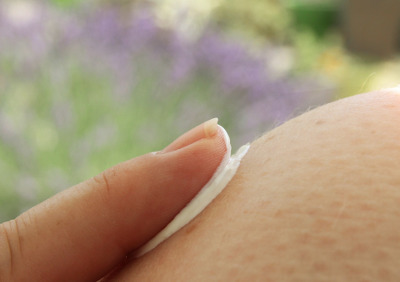CDT: Skin Care
 Skin care is probably the most important, and often overlooked, area of the Complete Decongestive Therapy, or CDT, process. Lymphedema and Lipo-Lymphedema people are at a higher risk of damage and infection in our skin. We must be careful to avoid bumping into objects or cutting ourselves to prevent unnecessary bruising and bleeding, which can lead to infection or open wound management. Open wounds make it more difficult or even impossible to proceed with further CDT treatment stages.
Skin care is probably the most important, and often overlooked, area of the Complete Decongestive Therapy, or CDT, process. Lymphedema and Lipo-Lymphedema people are at a higher risk of damage and infection in our skin. We must be careful to avoid bumping into objects or cutting ourselves to prevent unnecessary bruising and bleeding, which can lead to infection or open wound management. Open wounds make it more difficult or even impossible to proceed with further CDT treatment stages.
We must be vigilant in checking our skin and nails for any signs of cuts or wounds. A cut cuticle or even an ingrown hair follicle can present a challenge if not properly cared for before infection develops. Wounds or infections require immediate attention to prevent further complications to our system. Clean and bandage wounds as soon as detected or apply antibiotic topical creams to more advanced wounds or infections under a doctor or wound care specialists instruction. We need to prevent bouts of cellulitis at all costs! See our wound care page for more information.
People with Lymphedema or Lipo-Lymphedema may have areas of skin that are dry, rough, itchy, or discolored and leather-like to the touch. Use mild bar or body soaps with a soft washcloth or sponge to wash your affected areas. Be sure not to scrub or scratch these areas too hard. Pat dry your skin instead of rubbing to avoid tearing or breaking the skin. This is very important when drying wound areas or in between folds of skin where your skin is thinnest and prone to tears or rips.
After washing apply a healing lotion to non-infected areas of skin. I personally use Eucerin Intensive Repair Lotion all over. A little bit moisturizers a good size area. I have patches of dry eczema skin up and down my legs, itchy skin behind my knees and discolored leather-like skin around my ankles. The Eucerin moisturizers all these different areas very well. Of course there are other moisturizers out there that probably work just as well. Just make sure you keep your skin hydrated, supple and as soft as possible to help protect it from infection and ready for bandaging, if required.
From time to time you may also need to do a bit deeper exfoliating of your legs to remove dirt and other particles caught in between dimpled skin. I have a large lobule on the back of one of my legs that has many small to large papillomas (small sacs of skin and fluid that protrude from the epidermis or skin layer) where dirt regularly accumulates and basic showering cannot remove. Some people may also have this thicker bumpier surface near their ankles that may require additional skin care too.
You will need to get a mildly abrasive brush, sponge or glove, nothing so stiff that you risk ripping or damaging your skin, along with a gentle exfoliating cream to use in these areas. You may require assistance from someone else to help work in these hard to reach places. After your bath or shower gently rub in the exfoliating cream and let sit for a few minutes to work itself into the skin. Gently use a scrubbing brush, sponge or glove to rub small patches in a circular motion until dirt is gone or skin becomes tender. Stop working the area immediately if the patch hurts, turns red or tears! Do not attempt to exfoliate in any areas of infection or wounds! It may take two or three scrubs sessions before you can remove all the trapped dirt.
Also remember to use appropriate sunscreen when out in the sun. I find it difficult to be out in the sun for very long at my stage and usually opt to sit in the shade where I don’t need to regularly apply sun screen. I also avoid applying bug spray as my system usually reacts to the chemicals and prefer to sit where a citronella candle or other bug repellent system is present. Some may not react to these chemicals and are encouraged to protect their skin when working outside.
 Don’t forget that healthy glowing skin begins on the inside. The type of foods we eat directly reflect in our skin health. Eating the right foods can nourish the cells of skin, making them more elastic and supple. We will cover food in our nutrition section, but foods such as fish oil (omega 3), dark chocolate (yes, I said chocolate!), avocados, kale, broccoli, green tea and plenty of water for hydration are all great ways to feed your skin.
Don’t forget that healthy glowing skin begins on the inside. The type of foods we eat directly reflect in our skin health. Eating the right foods can nourish the cells of skin, making them more elastic and supple. We will cover food in our nutrition section, but foods such as fish oil (omega 3), dark chocolate (yes, I said chocolate!), avocados, kale, broccoli, green tea and plenty of water for hydration are all great ways to feed your skin.
Remember, diligent skin care is paramount to successfully completing the rest of the stages of the complete decongestive therapy process and managing your ongoing Lymphedema or Lipo-Lymphedema condition!
To your improved health!


Thanks so much for the article regarding comorbidities. I had so many of these and could never figure out how or why they were happening much less they were also somehow connected. I look forward to reading the other articles
Hello and you are welcome! Yes, Lipedema frequently is seen with one or more co-morbidities, most commonly lymphedema, hyper-mobility, osteoarthritis, MCAS and one or more autoimmune diseases. Sometimes it makes diagnosing a condition difficult when there are several, seemingly unrelated, prominent symptoms. It took me a couple misdiagnoses and rounds with a handful of doctors to figure out the 4 or 5 conditions going on in my system. The key is to keep listening to your body and questioning medical professionals when you believe there is more going on than just Lipedema to get to the root of these condition(s) and into treatment. There is no limit to the amount of co-morbidities you can have either! You just may find that by treating one or two major conditions you might alleviate or resolve several others. I’m glad you found this section helpful in sorting out your own health conditions. I will be updating this section further soon. Stay tuned!
Esther